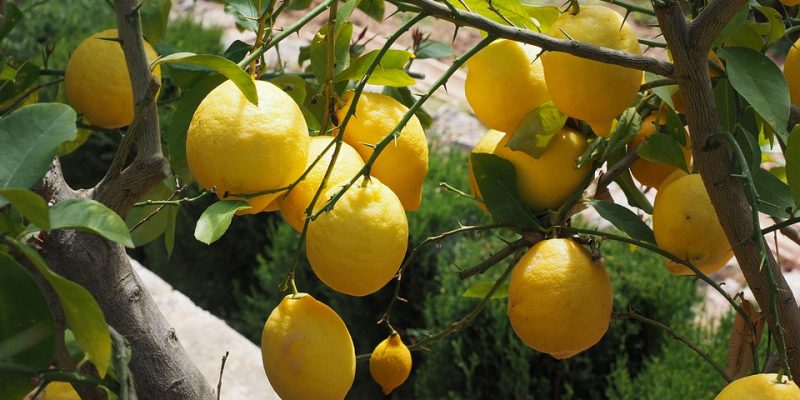One of the most common citrus trees for many gardeners is the lemon tree, whose tart and juicy fruits can offer a tasty addition to many dishes. Unfortunately, like any other plant or tree, joint problems may arise while cultivating a lemon tree: from pest infestations to incorrect watering schedules.
If you’re experiencing issues with your lemon tree but aren’t sure how to solve them, don’t worry – we’ve got you covered in this comprehensive guide on seven widespread lemon tree problems and how to resolve each one. Read on for more information and quick solutions so that you can get back to growing beautiful lemons again quickly.
Overwatering
One of the most common problems is an overwatered lemon tree. It’s easy to forget how long lemons can go between waterings, and overwatering can lead to the roots rotting and causing severe damage.
If you suspect that your tree may have been overwatered, it’s essential to check the soil around the tree’s roots. If they appear overly wet or spongy, overwatering is likely an issue. To fix this problem, reduce the amount of water you give the tree and allow the excess water in the soil to dry out before watering it again. Additionally, ensure that your lemon tree is planted in a well-draining pot with adequate drainage holes at the bottom.
Underwatering
On the other hand, underwatering is also a lemon tree problem that you can encounter. Without enough water, the leaves will start to curl and appear yellow. If you notice this happening to your tree, increase the amount of water given to it immediately.
In addition to overwatering, overwatering can also be caused by planting your lemon tree in soil that doesn’t drain well. To resolve this issue, ensure that your pot has adequate drainage holes at the bottom and mix some sand into the soil for extra drainage if needed.
Pest infestation
Pests such as mites, aphids, and whiteflies are a common problem for many citrus trees like lemons; these pests feed on the sap from the leaves and can cause yellowing, deformity, and even death of the branches.
To rid your lemon tree of pests, you should start by pruning off any dead or damaged leaves and branches as soon as possible. Additionally, it’s recommended to use a pesticide formulated for citrus trees to get rid of them more quickly. However, follow all instructions carefully when using pesticides, as these chemicals can be hazardous if misused.
Poor sunlight exposure
Lemon trees require plenty of sunlight to thrive; without adequate light exposure, the tree will become stunted and may have fewer fruits than desired. To ensure that your lemon tree is getting enough sun exposure, try planting it in a spot with at least six hours of direct sunlight each day.
If your tree is already planted in an area that receives ample sunlight, consider pruning or trimming branches blocking the sun from reaching it. Additionally, using reflective materials such as Mylar or aluminum foil can also help to increase the amount of light reflected onto the tree.
Nutrient deficiencies
Citrus trees require specific nutrients to maintain healthy growth; if these nutrients are not present in sufficient amounts, the yellowing and curling of leaves may result from nutrient deficiency. To ensure that your lemon tree gets all the necessary nutrients, fertilize it regularly with a fertilizer specifically designed for citrus trees.
If you’re unsure which fertilizer to use, your local garden center should be able to provide advice on which type of fertilizer is best suited for your lemon tree. Additionally, applying organic matter such as compost or manure every few months can help supplement the soil with the necessary nutrients and minerals for healthy growth.
Cold weather damage
Most varieties of lemon trees are sensitive to cold temperatures and can suffer from frost or freeze damage if exposed to temperatures below 35°F (2°C). To protect your lemon tree from cold weather damage, it’s crucial to cover it with a thick tarp during extreme temperature drops in winter.
Cold weather can also cause bud drop, which is when the blooms on the tree fall off before they can be pollinated. To prevent this from happening, wrap the trunk of your lemon tree with a burlap bag or towel to insulate it from extreme temperatures and keep it warm.
Disease
Many diseases, such as citrus canker and foot rot, can affect lemon trees. To prevent these diseases from occurring, make sure to keep your lemon tree clean and healthy by pruning off any dead or damaged branches, removing weeds around the base of the tree, and applying copper fungicide every few months.
In addition to disease prevention, it’s also important to regularly inspect the leaves and stems of your lemon tree for signs of infection. If you notice any discoloration or unusual growth patterns on the tree’s leaves or branches, contact an arborist as soon as possible for advice on how to proceed.
Conclusion
By recognizing and addressing common lemon tree problems, you can ensure that your citrus tree remains healthy and productive for years to come. Although there may be times when the best solution is to remove the affected tree, following these steps can help you prevent many of the most common issues from occurring in the first place. With regular maintenance, proper sunlight exposure, and adequate nutrients, your lemon tree should reward you with delicious fruits all season long.




















